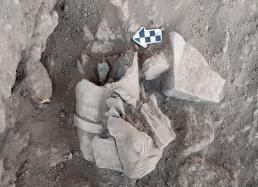2010: Ritual Spaces & Stonework
Excavations in 2010 revealed more of the story behind the dead man with the missing thighbone, first discovered in 2009. Dr. Feinman and his team kicked off the season by transferring their efforts to Terrace 57, adjacent to the man's burial cist. Like Terrace 56, excavated the year before, this new terrace contained a commoner’s residential complex—but one with a twist.
Most commoner’s houses consisted of a main patio surrounded on three sides by rooms used for sleeping and cooking. However, the north side of this house featured a plaster-floored room that was open to the patio and accessed via a low step faced with finely cut stonework, fitted together like a mosaic. Such details and craftsmanship are quite unusual for the home of a commoner, but more surprises were in store for the team....
Unusual Findings
At the entrance to plaster-floored room sat a Zapotec urn, placed in a recessed niche that faced the patio. When this occupational surface was rebuilt, the urn was ritualistically broken, so that the top figurative portion—which typically depicts a masked individual or supernatural being—had been removed. A single chert projectile point was positioned where the figurine’s head would have originally been located.
The unusual features of this commoner’s residence, its proximity to the burial cist containing the man with the missing femur, and the various phases of construction for the homes on both terraces have led Dr. Feinman to conclude the following: these two residential complexes appear to have housed generations of an extended commoner family in which a member of the household on Terrace 57 rose to become a leader in the neighborhood.
The Family Femur
Dr. Feinman suggests that, when a branch of the family began to rebuild their new residential complex atop Terrace 57, they exhumed the femur of a common ancestor (buried next door beneath their relative’s floor) to use as a sign of their special status or office—a popular practice typically seen only within ruling families and rare for ordinary citizens. That this new house contained a ritual space finished with fine stonework also testifies to the family’s unusual status.
However, when a later generation began to rebuild a new home over the basic footprint of this earlier, more elaborate residence, it appears that the family had lost their special standing in the community. Not only did this new house contain no such ritual space, its builders seemed to have ritualistically terminated the use of their forebear’s altar by removing the figurative urn’s sacred elements, symbolically “killing” the vessel with a projectile point, then burying the remnants beneath the new floor.
The Family Business
This later house contained evidence that stonework continued to be important to the family. Obsidian blades, worked chert, and even more elaborately carved figurative pieces signal that the family (and perhaps even all the households in the settlement) was involved in stone production.
These artifacts—and the beautiful stone façade facing the ritual space—help support the idea that the fantastic stonework seen much later at Mitla palaces was a long-held skill in the Mitla area, not an imported skill from another region of ancient Mesoamerica. To explore this topic further, please review Dr. Feinman’s Dispatch 4, May 14, 2010: The Stone Workers of Mitla.


